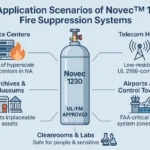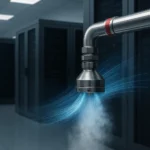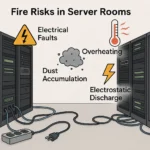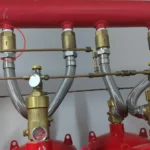In FM200 system design, common issues such as excessively long piping runs, too many 90-degree elbows, and excessive joints are often overlooked. These issues are not just trivial design flaws; they significantly impact system performance. The FM200 agent must be discharged to the furthest nozzle within 10 seconds, as required by NFPA 2001 standards. Even slight pressure drops or losses caused by tight corners or poorly placed joints can delay agent discharge, which in turn reduces the overall effectiveness of fire suppression.
For instance, in one large warehouse project, the design included multiple 90-degree elbows in the main piping route, resulting in a 12% pressure drop at the furthest nozzle. This minor loss caused a delay in agent discharge, extending the time it took to reach critical fire-prone areas. Such design oversights can compromise the safety and efficiency of the suppression system, especially in mission-critical environments such as data centers or power facilities.
To ensure optimal performance, it’s crucial to minimize unnecessary obstacles in the piping layout, maintain straight lines as much as possible, and adhere to best practices for nozzle placement and piping diameter. Proper design and installation are essential to meet both safety standards and the performance expectations of the system.
Common Design Pitfalls in Agent Transfer and Their Consequences

In FM200 system designs, certain critical mistakes in agent transfer are often overlooked, leading to significant performance issues. One of the most common errors is the use of excessively long piping runs. Long pipes introduce unnecessary friction, resulting in a pressure drop that delays agent discharge. For example, in a recent distribution center installation, a 200-foot long piping system with multiple 90-degree elbows resulted in a 15% pressure loss at the farthest nozzle, causing a 1.5-second delay in agent discharge. This delay violated NFPA 2001 requirements for fire suppression systems, which mandate agent delivery within 10 seconds.
Another frequent issue is the overuse of 90-degree elbows. These sharp bends cause turbulence in the flow, which not only reduces pressure but also slows the agent’s delivery. In a manufacturing facility installation, sharp bends in the piping network increased the pressure drop by another 12%, leading to an unacceptable delay in the agent reaching the critical zones of the building. In extreme cases, such issues can cause suppression failure in areas where the agent should have been delivered promptly.
Additionally, too many joints in the system can introduce further resistance, exacerbating the pressure drop and causing even more significant delays. For instance, a hospital system installation experienced issues when excessive joints were used in the piping network. These joints created multiple points for potential leakage and increased resistance, resulting in uneven agent distribution and failure to suppress fires in certain areas.
Each of these mistakes—whether due to long piping, excessive elbows, or an overabundance of joints—adds resistance that reduces the system’s overall effectiveness. The consequences can be severe: delays in agent discharge, violation of NFPA 2001 compliance, and an increased risk of fire hazards. Proper planning and design are critical to avoiding these costly mistakes and ensuring the system delivers its maximum efficiency when needed.
Pressure-Flow Optimization in FM200 Piping Design
To ensure optimal performance of an FM200 fire suppression system, the design must address key piping issues from the very beginning, incorporating both pressure-flow simulations and flow limiter calculations throughout the design process. These two essential elements help minimize friction losses, control pressure drops, and ensure that the agent is delivered to the farthest nozzle within the required 10-second discharge window.
Pressure-flow simulations allow engineers to model the system’s response under various conditions and identify potential problem areas such as long piping runs, sharp bends, or excessive fittings. Using Computational Fluid Dynamics (CFD) tools, engineers can simulate how the agent will flow through the system and visualize any pressure drop caused by friction or turbulence. For example, in a recent pharmaceutical facility project, CFD simulations identified that multiple 90-degree elbows caused a 12% pressure loss, which resulted in a 0.8-second delay in agent discharge to the farthest nozzles. By addressing this issue early in the design, the system was optimized to meet NFPA 2001 compliance.
In addition to simulations, flow limiter calculations are critical to maintaining an even flow rate throughout the piping system. These calculations ensure that the right amount of agent is delivered to each nozzle, preventing areas from receiving too little or too much agent. Engineers must account for the pipe diameter, fitting types, and nozzle configuration when calculating flow rates. For instance, if the diameter of the pipe is too large or too small, it can lead to uneven pressure distribution, which affects the system’s overall efficiency. In a case involving a data center, the calculation of appropriate pipe diameters and nozzle sizes ensured that agent flow was balanced across the entire facility, eliminating potential dead zones.
By integrating pressure-flow simulations and flow limiter calculations into the design process, engineers can avoid common pitfalls such as excessive pressure drop, inefficient agent distribution, and delayed suppression times. This comprehensive approach ensures that the FM200 system operates at peak efficiency, providing reliable and timely fire suppression in any environment.
Proper FM200 system design requires careful attention to piping layout, pressure-flow simulations, and flow limiter calculations. By addressing common design pitfalls like excessive pressure drop and agent delays, you ensure reliable and effective fire suppression.
Contact Flarenix today to consult with our engineering team and optimize your FM200 system design for maximum efficiency and compliance.




